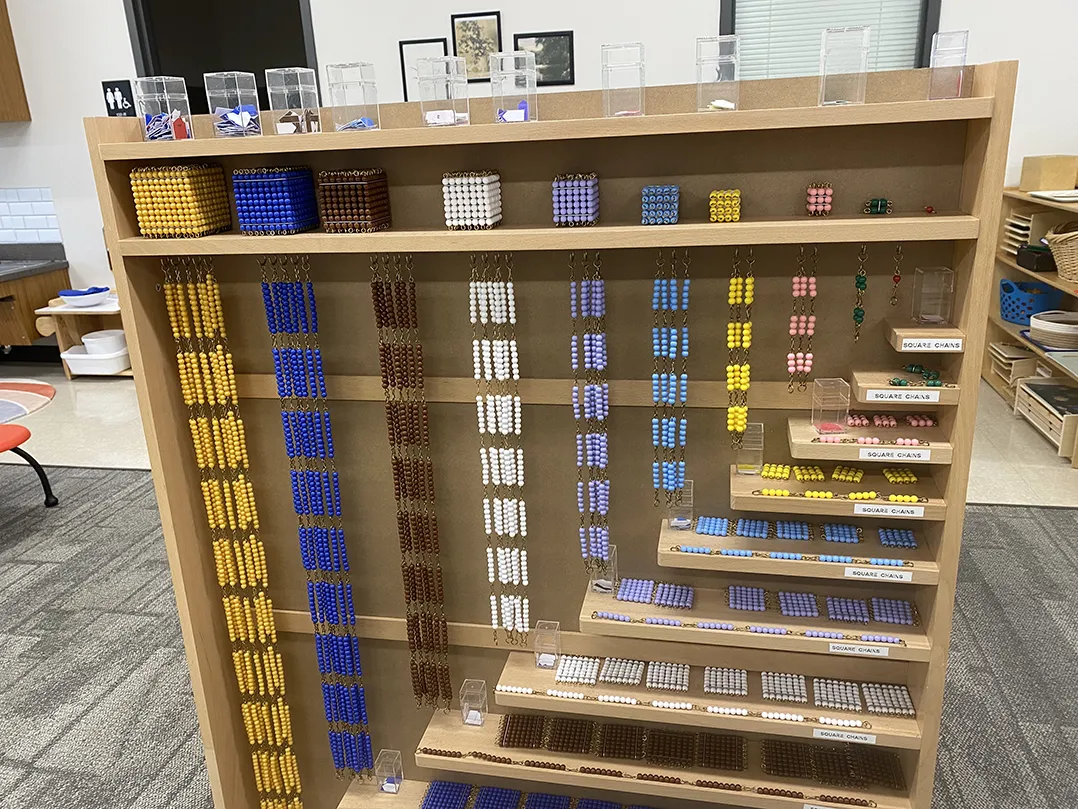Geist Montessori Academy started as a small, private preschool founded by a group of parents, but has grown into a multigrade public charter school that serves about 300 students in the central Indiana region.
A few days before the start of school, teachers were arriving to set up their classrooms at the school building, 6058 W. 900 North in McCordsville. GMA Executive Director Jennifer Gosch took a break from greeting teachers to talk about what the school offers.
She said GMA became a public charter school in 2006 under Ball State University, with no tuition charged for students in kindergarten through eighth grade. The school continues to offer tuition-based preschool. As a public charter school, Gosch said, GMA is subject to all the state’s education regulations. But, she said, “as a Montessori school, we get to do things a little bit differently.”
Working within state guidelines, GMA follows the instructional philosophy developed in the early 1900s by Maria Montessori, an Italian doctor.

“She was really a mover and a shaker in her time,” Gosch said. “Through her scientific work, she observed children — specifically, she worked with mentally disabled children who, at that time, would have been cast out and kind of just left to their own devices.”
Gosch said Montessori realized the methods and materials she developed while teaching those children would work for all kids, and started the alternative education movement that bears her name.
Gosch said the Montessori method can be a good option for kids who don’t do well in traditional schools.
“A lot of times in traditional, larger district schools, there’s a real push on academics and academics are king — and definitely academics are important, but an academic mark isn’t the only measure of a child’s success,” she said. “Dr. Montessori really believed in whole-child education.”
At a Montessori school, kids learn at their own pace rather than learning specific subjects at specific grade levels, Gosch said. GMA also teaches certain subjects in a different order than traditional schools.
“For example … when I went to school, we learned how to add, subtract, multiply and then divide,” Gosch said. “But Dr. Montessori knew that it was developmentally appropriate for children to learn how to add and then multiply, to subtract and then divide.”
Because those subjects are taught in a different order, Gosch said GMA students don’t always perform as well on state-required grade-level standardized tests.
“It’s not that they don’t know; it’s that they haven’t had that lesson yet,” she said, adding that scores improve in later grades. “It really is kind of this tricky balance of trying to adhere to the Montessori philosophy and the scope and sequence of a Montessori curriculum, and balance that with the accountability that comes with the state standards and being a public school.”
She noted that a Montessori education is something parents should be committed to, because the benefits are cumulative. GMA also doesn’t offer transportation, so while it’s open to all children in Indiana, most of the students live within relatively easy driving distance for parents.
“We pull a lot of families who live in Hamilton Southeastern or Mount Vernon or Lawrence Township (school districts),” Gosch said. “But we also have families that are coming to us from Westfield and Carmel and New Palestine, Pendleton, Anderson. There was a family who was driving from Muncie every day. But the family that was driving from Muncie decided to move to McCordsville, because they’re like, ‘We love the school, but we can’t keep doing the drive,’ so they moved to be closer to the school.”
GMA has combined classrooms, so children have the same teacher for two years. Gosch said instruction is different from a traditional classroom, with more small-group teaching followed by kids working on their own assignments.
“For the majority of their day, they’re working very independently and develop time management, prioritization of tasks, handling a workload — all of these things that I’m still working on as an adult,” she said.
Each classroom has a lead teacher and an assistant teacher who can provide guidance or answer questions.
Lead teacher Elise Anderson, who has taught at GMA for three years, was setting up her fifth- and sixth-grade classroom. She said she likes the big-picture concept of a Montessori education, along with the respect and encouragement the teaching method gives to students.
“The encouragement that they are capable — they are capable of being peacemakers; they are capable of taking care of an environment; they are capable of making decisions on their work,” she said. “I think that builds a lot of life skills that are needed later in life.”
Anderson said her own kids attend GMA, which shows how much she appreciates the teaching method.
For more about Geist Montessori Academy, visit gmacademy.org.

Who was Montessori?
According to the American Montessori Society, Maria Montessori founded a childcare center in a poor inner-city district in Rome in February 1907 — the Casa dei Bambini, or Children’s House — and began developing her unique education method.
“While the children were unruly at first, they soon showed great interest in working with puzzles, learning to prepare meals, clean their environment and engaging in hands-on learning experiences,” the website states. “Dr. Montessori observed that, before long, the children exhibited calm, peaceful behavior, periods of deep concentration and a sense of order in caring for their environment. She saw that the children absorbed knowledge from their surroundings, essentially teaching themselves.”
Within a year, Montessori opened two more schools and in 1909 she published a book detailing her methods.
“By 1910, Montessori schools could be found throughout Western Europe and were being established around the world,” the website states. “In 1911, the first Montessori school opened in the United States.”
After an initial surge of Montessori schools in the U.S., the number declined in the 1920s, but picked back up again in the 1950s. Now, there are about 5,000 Montessori schools in the United States.
For more, visit amshq.org.




